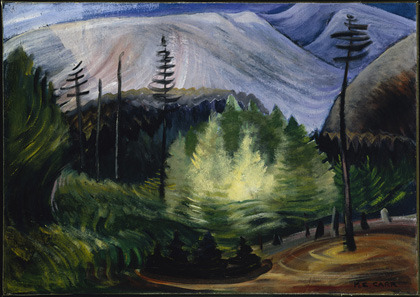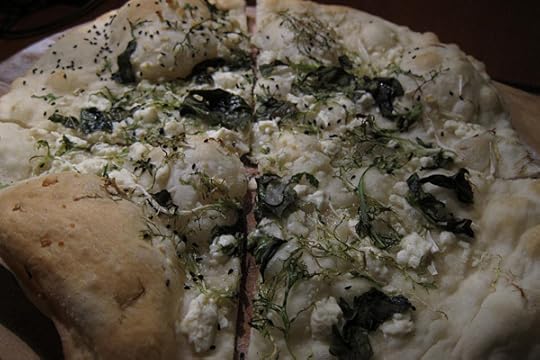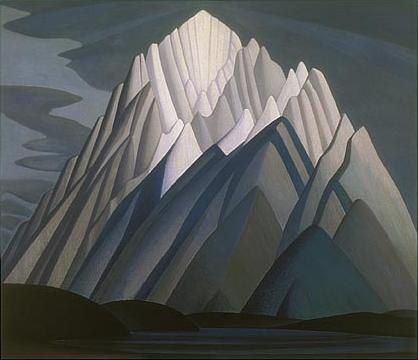Elizabeth Adams's Blog, page 103
February 14, 2012
More Emily Carr
Emily Carr, "New Growth," c. 1936
I am always asking myself the question, What is it you are struggling for? What is that vital thing the woods contain, possess, that you want? Why do you go back and back to the woods unsatisfied, longing to express something that is there and not able to find it? This I know, I shall not find it until it comes out of my inner self, until the God quality in me is in tune with the God in it. Only by right living and a right attitude towards my fellow man, only by intense striving to get in touch, in tune with, the Infinite, shall I find that deep thing hidden there, and that will not be until my vision is clear enough to see, until I have learned and fully realize my relationship to the Infinite...
Search for the reality of each object, that is, its real and only beauty; recognize our relationship with all life; say to every animate and inanimate thing "brother;" be at one with all things, finding the divine in all; when one can do this, maybe then one can paint. In the meantime one must go steadily on with open mind, courageously alert, waiting always for a lead, constantly watching, constantly praying, meditating much and not worrying...
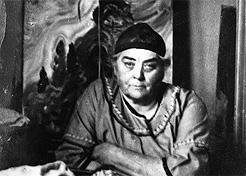 Then she quotes Whitman's Song of the Rolling Earth:
Then she quotes Whitman's Song of the Rolling Earth:
"Say on, sayers! sing on, singers!
Delve! mould! pile the world of the earth!
Work on, age after age, nothing is to be lost,
It may have to wait long, but it will certainly come in use,
When the materials are all prepared and ready, the architects shall appear."
And concludes:
So -- no matter if we are not to make the goal ourselves. All our work helps us to accumulate material for the great final structure. Our business is to do our own small part with absolutely no thought of personal aggrandisement or glory.
Emily Carr, Hundreds and Thousands, the Journals of Emily Carr
Such sentiments sound so old-fashioned in our cynical and materialistic age. There's the language itself, but more so the idealistic selflessness, the notion that we would actually do something difficult, strive hard over an entire lifetime, not for ourselves, but because we have faith that it will all mean something in the end: that this human project is actually has a greater goal and we each have our part in it. I wonder how many people (other than dedicated parents, who do think this way still) even entertain thoughts like this today, let alone base their lives on them -- but this sense of the nobility of human endeavor used to be widespread. I don't think you have to be traditionally religious to have this sense of purpose and meaning; but you do need to have read, looked deeply at the arts, thought about "creation" in a very broad sense, and felt the desire to try to do something yourself as well as you possibly can, to swim in that stream of human endeavor, inspired by something besides dreams of personal grandeur.
February 11, 2012
If only you could eat a photo: homemade pizza
Pizza is J.'s specialty. He made a particularly good batch of dough this week and we had two night's worth of astounding pizzas. They had a puffy, crackly, but tender crust that kind of exploded in the very hot oven (he cooks his pizzas on an oven rack lined with quarry tiles, then transfers them to the upper rack to finish). The top one, a white pizza, had feta cheese, frise lettuce, fresh basil and parsley, black olives, and onion seed on a crust brushed with olive oil: it looked like an embroidered wedding dress!
Anatomy of a perfect pizza-bubble.

And a somewhat more conventional pizza with homemade fresh tomato sauce, meatballs, mushrooms, a bit of mozzarella, and fresh basil. Oh my.
February 9, 2012
Mountain and Pasture, a new drawing
I finished this charcoal drawing today, another one in my current Iceland series. When we passed this mountain, on the way out of Reykjavik toward Thingvellir, we simply had to stop the car and get out to take photographs. The home of the great Icelandic author, Haldor Laxness, is nearby, too.
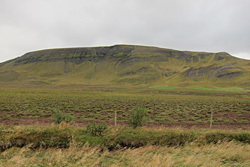 It was only when we looked much closer that we realized there were sheep in the pastures -- just recently down in the valley from their summer grazing much higher up.
It was only when we looked much closer that we realized there were sheep in the pastures -- just recently down in the valley from their summer grazing much higher up.
You can view a slideshow of the drawing in process at my site on Flickr.
February 7, 2012
Emily Carr
Fifty-six years ago tonight there was a big storm out West and deep snow. My dear little Mother wrestled bravely and I was born and the storm has never quite lulled in my life. I've always been tossing and wrestling and buffeting it. How little I've accomplished! And the precious years are flying by and never, never one minute will the clock tick backwards.
--Emily Carr
In January I read Hundreds and Thousands, the journals of the iconic Canadian landscape painter and writer Emily Carr (1871-1945). The book was given to me by an old friend who saw an affinity between my own struggles and musings -- known to him from this blog and our conversations that began back when we were eighteen -- and Carr's internal dialogue set down so vividly in her clear prose.
The journals begin in the mid-1920s, when Carr is in her fifties, trying to break through into a new way of expressing the landscape and what she feels about nature. She was essentially a recluse who lived with a menagerie of animals, including a rat and a monkey, and spent much of each summer camping and painting in the Pacific Northwest in a caravan she dubbed "The Elephant." She was as crusty, abrasive, and impatient as she was intelligent, sensitive, and determined; loyal to her sisters continually fail to understand her; loyal too, but annoyed by the rituals, hierarchy and dogma of the Anglican Church, which seemed so removed from her own sense of an unknowable, loving God permeating all of creation.
My friend was right: I read with an immediate sense of empathy, recognition, gratitude. They're as necessary to me as the living, these dear dead friends met in books, or felt in the brushwork of a painting or a vibrant line in a drawing, for sometimes it's so hard to explain ourselves to the real-life people who stop by the studio or read our scribblings, as Emily called her journals and stories.
---
In 1929, Carr came to Montreal -- a rare visit to the East -- encountering the work of the Group of Seven for the first time and becoming particularly enamored with the paintings of Lawren Harris:
Lawren Harris, "Mountain Forms." He painted a number of variations of this subject and from her description I don't think this the exact one Carr saw in Montreal.
Harris's 'Mountain Forms' was beautiful. It occupied the centre of one wall – one great cone filled with snow and serenely rising to a sky filled with wonderful light round it in halo-like circles. Forms purplish in colour lead up to it. He gets a strip of glorious cold green in the foreground and the whole sky is sublimely serene.
I sat and watched it for a long, long time. I wished I could sweep the rest of the wall bare. The other pictures jarred. Two fashionable women came in and called others. They laughed and scoffed. After wondering if the thing was an angel cake, they consulted the catalogue. It is 'Mountain Forms.' " They all laughed. How I longed to slap them! Others came and passed without giving more than a brief, withering glance. A priest came. Surely he would understand. Wouldn't the spirituality of the thing appeal to one whose life was supposed to be given to these things? He passed right by even though he walked twice through the room – blind, blind!
Soon she met Harris, and spent a long time at his studio.
...I wonder if he [Lawren Harris] realizes how I appreciate his generosity and what the day meant to me in trying to solve the riddles and mysteries that I've plugged along with alone for so long. Of this I am convinced: that he has come up to where he now is by diligent, intelligent grinding and wrestling and digging things out; that he couldn't do what he is doing now without doing what he has already done; that his religion, whatever it is, and his painting are one and the same. I wonder where he'll rise to. In eight years his work has changed entirely. In eight years more what will happen to it?
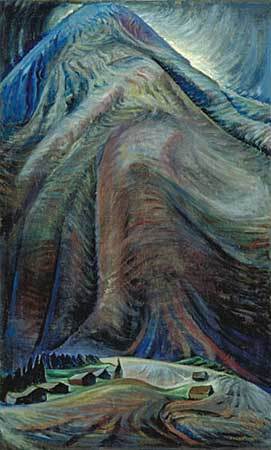 They became friends, corresponding by letter for many years. Eventually Carr parted ways with Harris and The Group of Seven, who were Theosophists, and had a view of God as cold and remote that she simply couldn't share.
They became friends, corresponding by letter for many years. Eventually Carr parted ways with Harris and The Group of Seven, who were Theosophists, and had a view of God as cold and remote that she simply couldn't share.
I loved reading about Carr's working life, both in general terms and when she talks about the gestation and progress of a particular painting or drawing. We share a great deal about our feelings for place, landscape, spirituality, and identity. But I'm especially moved when she writes about the swift passage of time, about getting older and more tired, and still pressing on toward the elusive goal of expressing the inexpressible, the truth as she sees it. For that's the challenge, I think, of this stage in life: finding a way to keep going with courage and happiness and determination, even when age begins to affect our physical body and the acquisitive desires of youth and middle age are seen clearly and set aside, whether with disappointment and discouragement, or relief. It would be so much easier to simply retirer, to use the French word from which we get both "retire", and "retreat:" many do. But for the artist, I don't think this is an option, so we have to dig down deep, and enter the solitude where we -- paradoxically -- sometimes find staunchest companions.
The Mountain, Emily Carr, 1933
February 2, 2012
Wislawa Szymborska
 Sometimes the world goes a little more silent, and so it was yesterday when I heard of the death of Wislawa Szymborska. In her 88 years she had only published 400 poems, saying that she wrote many more, but always re-read the previous day's work the next morning: "Many," she added dryly, "don't survive." So this was a poet who was not prolific, nor had she had fallen in love with the sound of her own voice. Instead, each poem said something that mattered, and therefore the silence today is multiplied.
Sometimes the world goes a little more silent, and so it was yesterday when I heard of the death of Wislawa Szymborska. In her 88 years she had only published 400 poems, saying that she wrote many more, but always re-read the previous day's work the next morning: "Many," she added dryly, "don't survive." So this was a poet who was not prolific, nor had she had fallen in love with the sound of her own voice. Instead, each poem said something that mattered, and therefore the silence today is multiplied.
My own attraction to Polish poetry began perhaps fifteen years ago, or even more, after I had gone on a two-year binge of reading Russian literature, ending up with Akhmatova and Mandelstam. From there, in my search for voices of survival, hope, and sustenance among intellectuals and artists during times of war, and what I perceived as both social decay and indifference to what was really happening, I moved to the post-WWII poets of Poland. I was mainly drawn to Zbigniew Herbert, Tadeusz Rozewicz, Czeslaw Milosz, and their younger colleague Adam Zagajewski: all poets who wrote beautiful poems about the darkness and the light.
In 1996, Szymborska won the Nobel Prize for Literature. I bought her book View with a Grain of Sand, but didn't particularly like it at first. Somewhere around that time, I had a conversation about these Polish poets with my friend Kingsley, who had been a headmaster in a NYC Episcopal school and was a great reader as well as a man of strong and considered opinions ."She seems so...ironic, and almost flip," I said. "There's a sort of black humor in her work, and I guess I'm more attracted to the lyricism of the others...you know, the apricots hanging from the tree, the memories of past loves, the beauty in spite of everything that's happened." K. , who was about thirty years olderthan I was, laughed and said, "Yes, but that's exactly what I like about Szymborska. She's unflinching, she doesn't paper over anything, yet there's a humor and irony in her writing. Just wait -- I think you'll come to appreciate her more."
He was right, and it didn't take long. So much happened in the next ten years, and it changed me. After seeing death several times over, after loss and grief, after watching my country change irreparably, after leaving my home and reconsidering most of my beliefs, I found that the way I had looked at the world before no longer served: it had been well-considered theory, but not a lived reality. I had become more skeptical and less idealistic; stronger but also more cognizant of human frailty; more aware of the beauty in everyday life and the poignancy of each moment. I had found that humor was a great ally in dealing with the worst of things, and also with helping others to cope, and that the absurd is never far from the most serious human endeavor, especially in the way we seem to refuse to learn anything from our own history.
When I returned to Szymborska, it was immediately clear to me that K. had been right. I often had her poetry on my bedside table, and always found something truthful that made me nod my head with both admiration for her, and determination for the next day. But her poetry was never harsh or unfeeling; quite the contrary. She simply refused to be sentimental, and faced things as they really were. Now I think I saw in her a particular kind of strength that was female, and with which I increasingly indentified. The only words I can find to encapsulate Szymborska are "a soft toughness." You can see it in her face.
She hasn't talked a great deal about herself, but I liked this quote, from Szymborska's obituary in The Guardian:
"Everyone needs solitude, especially a person who is used to thinking about what she experiences. Solitude is very important in my work as a mode of inspiration, but isolation is not good in this respect. I am not writing poetry about isolation," she said, going on to wonder why anyone would want to interview her. "For the last few years my favourite phrase has been 'I don't know'. I've reached the age of self-knowledge, so I don't know anything. People who claim that they know something are responsible for most of the fuss in the world."
Yesterday, when I heard the news, it seemed ironic and coincidental that I had just taken down her book and quoted from it here two days before. But then again, perhaps it wasn't so odd, because, as I said, I re-read her poems often. It was Szymborska who I had planned to pick for Marly Youmans' "Lydian Stones" project - a choice that would probably seem too obvious now. But at the time, looking at the jacket photograph with her ever-present cigarette, I had wondered how she was doing, with no idea she was in the process of leaving the world.
Last night I read Szymborska again, trying to identify a favorite poem to copy here. There are too many, so it was impossible, but I'll settle on this one which is about a journey, and embodies the qualities I've tried to describe.
INTO THE ARK
An endless rain is just beginning.
Into the ark, for where else can you go:
you poems for a single voice,
private exultations,
unnecessary talents,
surplus curiosity,
short-range sorrows and fears,
eagerness to see things from all sides.
Rivers are swelling and bursting their banks.
Into the ark: all you chiaroscuros and halftones,
you details, ornaments, and whims,
silly exceptions,
forgotten signs,
countless shades of the color gray,
play for play's sake,
and tears of mirth.
As far as the eye can see, there's water
and a hazy horizon.
Into the ark: plans for the distant future,
joy in difference,
admiration for the better man,
choice not narrowed down to one of two,
outworn scruples,
time to think it over,
and the belief that all of this
will still come in handy some day.
For the sake of the children
that we still are,
fairy tales have happy endings.
That's the only finale that will do here, too.
The rain will stop,
the waves will subside,
the clouds will part
in the cleared-up sky,
and they'll be once more
what clouds overhead ought to be:
lofty and rather lighthearted
in their likeness to things
drying in the sun —
isles of bliss,
lambs,
cauliflowers,
diapers.
February 1, 2012
Hello February
"Cloud Streets" over the Bering Sea, from NASA's Earth Observatory, Jan 4, 2012. Thank you to G. for telling me about this treasure-trove of fascinating images.
...and back to regular blogging.
It's been good for me to take a break. Picking up thirty-one "small stones", found in various places, was a different way to spend January here, and surprisingly useful: some of those little pebbles of wisdom were actually pretty big and I hope I've still managed to swallow them whole! The holidays had been busy and for some reason really threw me off-stride where my own creative projects were concerned. I felt like I lost a lot of momentum, and am just now getting it back. Then too, there's always a dip in energy during this part of the winter here, for me at least. The clear cold days can be very beautiful and exhilarating, but the grey, slushy, icy ones are just the opposite: the tendency is to get up slowly, drive to the studio instead of walking (likewise, take the bus or metro instead of walking), stay indoors and get less exercise in general (and sometimes for good reason: several people I know have had really bad falls and ended up with broken wrists, shoulders, ankles), go home after dark, make dinner, and snuggle down under a comforter with a good book or a video.
I've been working on tech-y things this past month, not writing too much, and not drawing, but busy with singing, and playing a bit more piano in the evenings. I've read a couple of good books, too -- the latest being The Tiger's Wife, which I'll probably write something about here eventually. We've been watching BBC programs and documentaries: Downton Abbey, nature programs, Vladimir Putin, India, the Crusades. Not a bad change of pace, by any means.
At the cathedral, our new social justice action group has been getting more organized, and a few weekends ago I helped lead a brainstorming session on justice and faith which drew a surprising 26 people, including a number of new, young participants. People are concerned about our world, and the fact that they want to do something gives me hope; the least I can do is try to help with planning, organizing, publicizing. And soon Lent will be here; I've been asked to lead a session or two at the annual quiet retreat, possibly on writing as a spiritual practice.
I had my annual medical exams...all OK, so far as anyone can tell...it's always something I'm glad to get behind me, and yet I'm grateful: for the record, we're getting much more thorough and comprehensive care than we did in the U.S., for vastly less money, and that's the norm here for everyone.
Meanwhile, friends are flying to Barbados, Cuba, Florida, Panama, Costa Rica, Mexico...but I don't think we're going anywhere this winter because we're waiting for the contractor to begin the renovations on our bathrooms after last year's flood from the apartment above. So things feel basically good as the month begins, but a bit up-in-the-air: how are they with you?
January 31, 2012
31.b, and goodbye to January, which was full and is now empty
Treatise on Emptiness
In a bookstore I accidentally ended up at the section on Tao, or
more precisely, by the Treatise on Emptiness.
I rejoiced, since that day I was perfectly empty.
What an unexpected meeting -- the patient finds the doctor,
the doctor doesn't speak.
--Adam Zagajewski, from "Without End"
31.
30. Belatedly
One always dies too soon or too late. And yet, life is there, finished: the line is drawn, and it must all be added up. You are nothing other than your life.
Jean-Paul Sartre
It is never too late to be what you might have been.
George Eliot
Which form of proverb do you prefer: Better late than never, or Better never than late?
Lewis Carroll
January 29, 2012
29. The beauty of the unconscious
The beauty of the unconscious is that it knows a great deal—whether personal or collective—but it always knows that it does not know, cannot say, and dare not try to prove or assert too strongly; because what it does know is that there is always more—and all words will fall short. The contemplative is precisely the person who agrees to live in that unique kind of brightness (a combination of light and dark that is brighter still!). The Paradox, of course, is that it does not feel like brightness at all, but what John of the Cross calls a "luminous darkness," or others call "learned ignorance."
In summary, you cannot grow in the great art form, the integration of action and contemplation, without 1) a strong tolerance for ambiguity; 2) an ability to allow, forgive, and contain a certain degree of anxiety; and 3) a willingness to not know and not even need to know. This is how you allow and encounter mystery. All else is mere religion.
Fr. Richard Rohr

